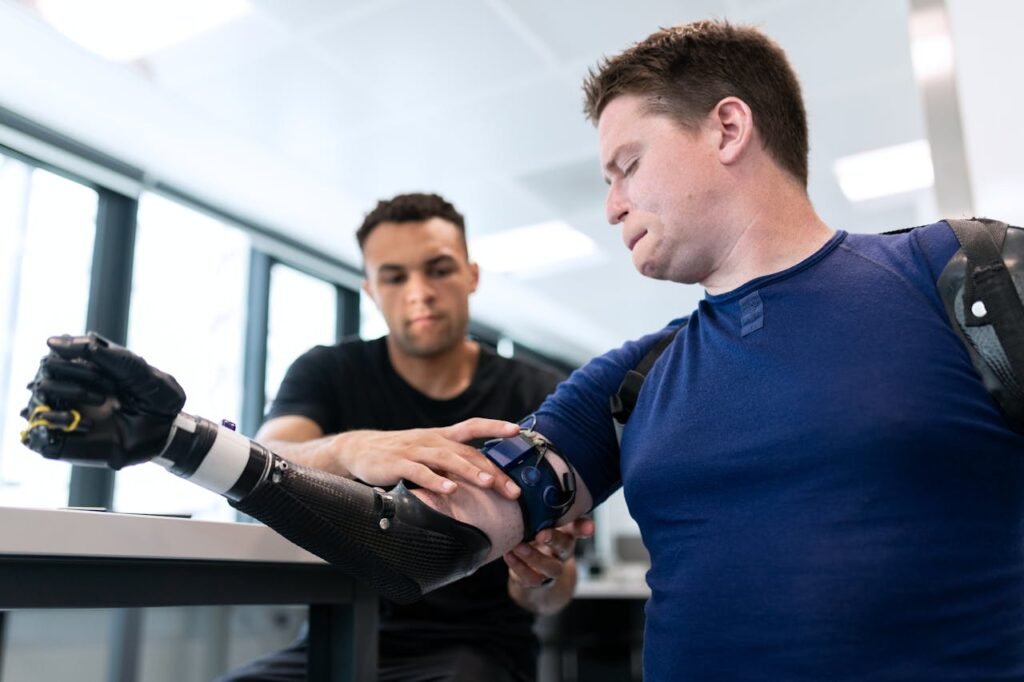For centuries, the battlefield has been a crucible of innovation, driving advancements that often find their way into civilian life. Nowhere is this more evident than in the field of prosthetics. Military research and development have spurred groundbreaking technologies designed to restore mobility, independence, and dignity to injured soldiers. These innovations, born from necessity, are transforming the way we think about prosthetics and their potential in everyday life.
At Robobionics, we recognize the immense contributions of military-led advancements to modern prosthetic technology. From rugged designs built to endure extreme conditions to cutting-edge control systems inspired by the demands of combat, the lessons from battlefield prosthetics are shaping the future of this field.
Origins of Battlefield Prosthetics
The use of prosthetics in military settings has a long history, dating back to ancient times when wooden limbs and iron hooks were crafted for injured warriors. While these early devices were rudimentary and focused solely on function, they marked the beginning of a journey that would intertwine innovation with necessity.
Lessons from World Wars
The two World Wars of the 20th century saw unprecedented advancements in prosthetic design and manufacturing. With thousands of soldiers returning home with amputations, governments and medical institutions were forced to prioritize the development of prosthetic solutions.
Lightweight materials like aluminum replaced heavy wood and steel, while mass production techniques ensured that devices could be distributed quickly and affordably.
These innovations laid the groundwork for modern prosthetics, shifting the focus from basic functionality to designs that enhanced user comfort and mobility.
For example, the introduction of articulating joints during this era allowed for greater range of motion, setting the stage for today’s advanced multi-articulating prosthetic hands.
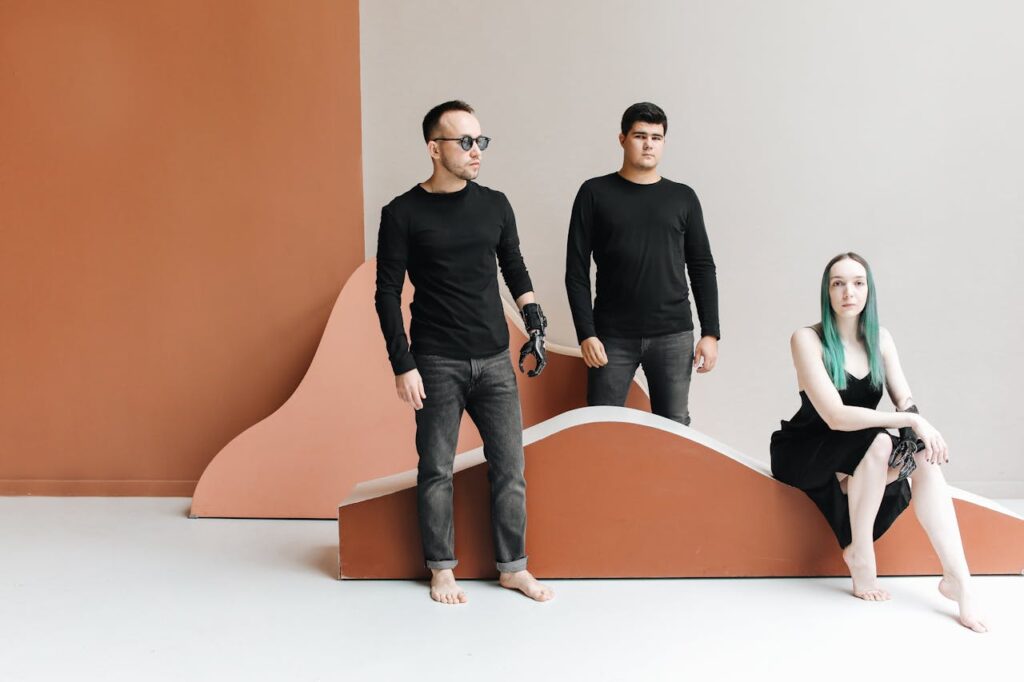
Ancient Innovations: The First Prosthetic Solutions
The concept of prosthetics can be traced back to ancient civilizations, where crude devices made of wood, leather, and metal were designed to help injured warriors return to the battlefield or adapt to civilian life.
For example, a 3,000-year-old wooden toe discovered in Egypt is one of the earliest known prosthetic devices, highlighting humanity’s long-standing desire to restore mobility and normalcy after limb loss.
These early solutions prioritized functionality over aesthetics, emphasizing the practical needs of users. For businesses today, this historical precedent underscores the importance of understanding user requirements and tailoring designs to meet specific challenges.
Developing prosthetics that align with an individual’s daily activities, environment, and personal preferences remains a key strategy for success.
The Turning Point: Battlefield Needs Driving Innovation
The medieval period saw a shift in prosthetic design as combat became more mechanized and injuries more severe. Iron limbs, hooks, and peg legs were common during this time, reflecting the need for rugged devices that could endure the harsh conditions of war.
These prosthetics were often made by blacksmiths and armorers, who applied their expertise in metalworking to create durable solutions.
This era highlights a critical lesson for modern prosthetics manufacturers: collaboration with experts from other fields can lead to groundbreaking innovations.
Today, partnerships with material scientists, engineers, and healthcare professionals are essential for pushing the boundaries of what prosthetics can achieve.
By fostering interdisciplinary collaboration, businesses can develop devices that are both functional and transformative.
The Industrial Revolution: Scaling Prosthetic Development
The industrial revolution marked another significant turning point in the history of battlefield prosthetics. With wars becoming larger in scale, the demand for prosthetics surged, particularly during and after conflicts like the Napoleonic Wars.
Mass production techniques allowed for the rapid manufacturing of standardized prosthetic limbs, making them more accessible to a broader population.
For modern businesses, this historical phase offers insights into the importance of scalability and efficiency. The prosthetics industry today faces similar challenges in meeting growing demand, particularly in underserved regions.
Leveraging modern manufacturing techniques like 3D printing and automation can address these challenges, enabling cost-effective production of custom-fit devices that combine precision with accessibility.
World Wars: Advancing Technology and User-Centric Design
The two World Wars of the 20th century were pivotal in the evolution of prosthetics. The sheer number of soldiers returning home with amputations forced governments and medical institutions to innovate rapidly.
This period saw the introduction of lightweight materials like aluminum and the development of articulating joints, which allowed for greater mobility and functionality.
The emphasis on rehabilitating injured soldiers also brought attention to the psychological and social aspects of limb loss. Prosthetics were no longer viewed as purely functional devices but as tools for restoring confidence and reintegrating individuals into society.

The Modern Era: Military Innovations and Their Impact
In recent decades, military investments in prosthetic technology have reached new heights, driven by the challenges faced by soldiers in modern combat. From the rugged terrains of Afghanistan to urban warfare scenarios, the demands of the battlefield have inspired prosthetics that are more durable, adaptable, and technologically sophisticated than ever before.
Advanced Materials for Durability
One of the key lessons from military prosthetics is the importance of materials that can withstand extreme conditions. Soldiers operating in harsh environments need devices that are both lightweight and incredibly tough, capable of enduring heat, cold, moisture, and impact.
Military research has driven the development of advanced composites, such as carbon fiber and titanium alloys, which combine strength and durability with a lighter weight.
These materials not only enhance the functionality of prosthetics but also reduce fatigue, allowing users to wear their devices for extended periods without discomfort.
At Robobionics, we’ve adopted similar principles, integrating military-grade materials into our designs to ensure that our prosthetics deliver exceptional performance and reliability, even in demanding circumstances.
Smarter Control Systems
Another major contribution from military research is the advancement of control systems that allow prosthetic devices to respond intuitively to user intent.
Myoelectric sensors, which detect electrical signals from the muscles, have been refined through military-funded programs to deliver faster and more accurate responses.
More recently, military prosthetics have incorporated neural interfaces that connect directly to the user’s nervous system, enabling control through thought alone.
These brain-controlled systems, initially developed to restore function for soldiers with severe injuries, are now finding applications in civilian prosthetics, offering new levels of precision and usability.
Businesses in the prosthetics field can learn from these advancements by investing in research and partnerships that push the boundaries of intuitive control.
Collaborating with tech companies and universities that specialize in AI and robotics can help bring these innovations to a broader audience.
Adaptability and Modularity: Lessons from Combat Scenarios
Military prosthetics are often designed with adaptability in mind, reflecting the unpredictable and demanding nature of combat scenarios. Soldiers may require prosthetic devices that can function across various terrains, handle heavy-duty tasks, and adjust to different levels of physical exertion.
Modular Designs for Versatility
In the military, modular prosthetics have become a game-changer. Soldiers can swap out components of their prosthetic limbs to suit specific tasks, such as attaching a rugged grip for climbing or a specialized attachment for operating machinery.
This flexibility ensures that users can perform a wide range of activities without needing multiple devices.
For civilian applications, this concept has immense potential. A user who enjoys both office work and outdoor sports could benefit from a prosthetic arm with interchangeable components that adapt to different activities.
Businesses can capitalize on this trend by offering modular designs that cater to specific user needs, enhancing both functionality and user satisfaction.
At Robobionics, we’ve embraced modularity as a core principle in our prosthetic designs, ensuring that users can customize their devices to match their unique lifestyles and goals.
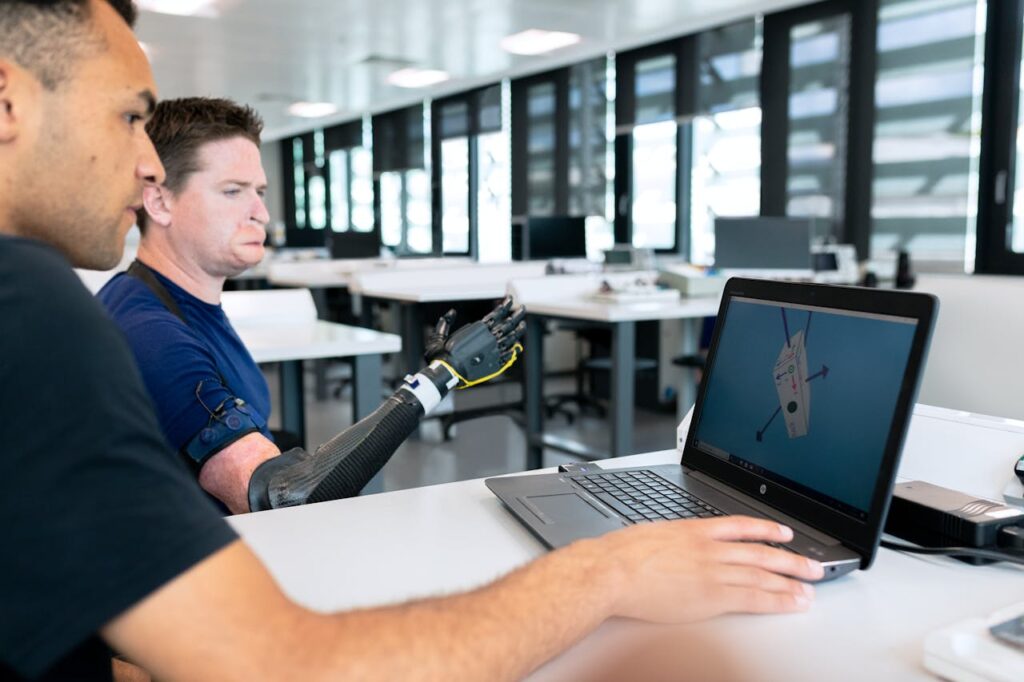
Enhancing Adaptation Through Training
Another lesson from the military is the emphasis on training to help users adapt to advanced prosthetics. Soldiers recovering from limb loss often undergo extensive rehabilitation programs to learn how to maximize the potential of their devices.
These programs incorporate cutting-edge tools, such as virtual reality (VR) simulations, which allow users to practice real-world tasks in a controlled environment.
For businesses, integrating training programs alongside prosthetic solutions can significantly improve user outcomes. Providing access to interactive training tools, online tutorials, and support from occupational therapists can ensure that users feel confident and capable with their devices.
Embracing Sustainability in Prosthetic Design
In recent years, the military has also focused on sustainability in prosthetic development. This reflects broader trends in engineering and manufacturing, where eco-conscious practices are becoming a priority.
By incorporating sustainable materials and energy-efficient systems, military prosthetics aim to reduce environmental impact without compromising performance.
Bio-Inspired Materials
One of the most exciting developments in this area is the use of bio-inspired materials, which mimic the properties of natural tissues. These materials, developed through military-funded research, are biodegradable and recyclable, offering an eco-friendly alternative to traditional composites.
For example, polymers derived from renewable sources can provide the same strength and flexibility as petroleum-based plastics but with a lower carbon footprint.
Robobionics is exploring similar avenues, leveraging sustainable materials to create prosthetics that align with our commitment to environmental responsibility.
By integrating eco-friendly practices into our manufacturing processes, we aim to set a new standard for sustainability in the prosthetics industry.
Bridging the Gap Between Military and Civilian Applications
The advancements in military prosthetics offer valuable lessons for civilian applications, but translating these innovations into everyday use requires careful consideration of accessibility, affordability, and practicality.
While military-grade prosthetics often involve high costs and specialized designs, businesses must focus on creating solutions that balance advanced features with user-centric affordability.
Collaboration for Wider Impact
Collaboration between military researchers, private manufacturers, and healthcare providers is key to bridging this gap. By sharing knowledge and resources, stakeholders can accelerate the adoption of military innovations in civilian prosthetics.
For example, businesses can partner with military research labs to refine neural interface technology or work with rehabilitation centers to incorporate modular training programs.
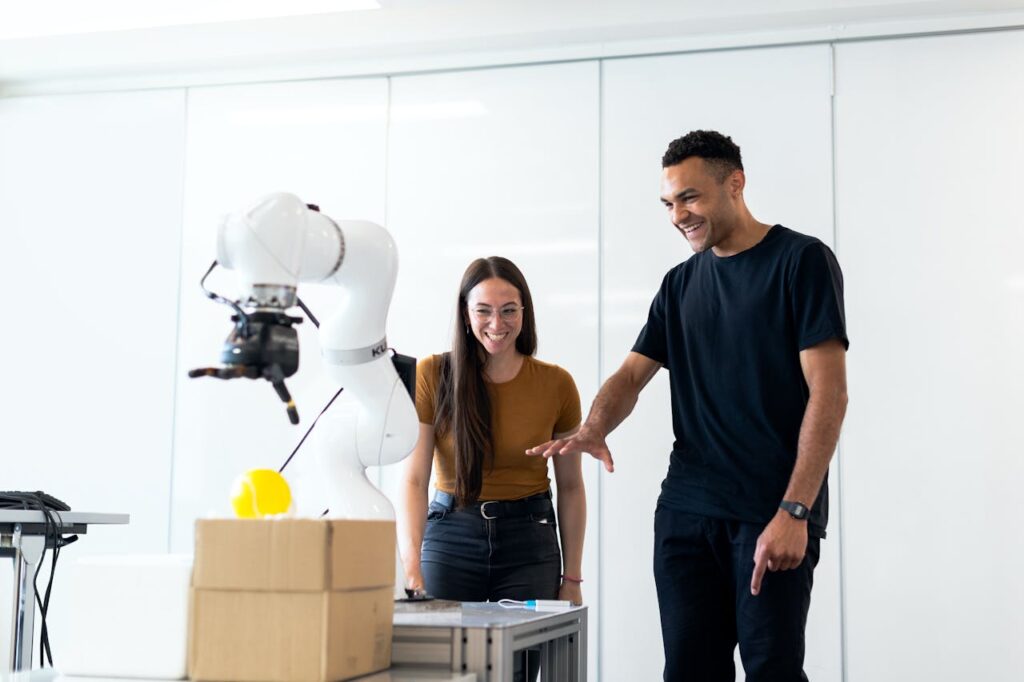
At Robobionics, we’re committed to fostering these collaborations, ensuring that the most impactful military advancements are adapted to serve a wider audience.
By doing so, we hope to make cutting-edge prosthetics more accessible and transform lives across diverse communities.
The Human Element: Emotional Impact and Empowerment
Beyond the technical advancements, military innovations in prosthetics highlight the profound emotional and psychological impact of restoring mobility.
Soldiers recovering from limb loss often face not only physical challenges but also emotional hurdles, including rebuilding confidence and finding a renewed sense of identity.
Designing for Confidence
One of the key lessons from military prosthetics is the importance of aesthetics. For many users, the appearance of their prosthetic device can influence how they feel about themselves and how they engage with the world. Military programs often prioritize designs that look natural or reflect the user’s personality, offering customizable options that enhance confidence.
In civilian applications, prosthetic aesthetics should be equally prioritized. Offering a range of finishes, colors, and styles allows users to personalize their devices, turning them into expressions of individuality rather than reminders of loss.
Businesses can further this effort by involving users in the design process, ensuring that the final product resonates with their personal preferences.
At Robobionics, we understand the emotional significance of prosthetics and strive to create designs that instill pride and confidence in every user.
Supporting Mental Health Through Innovation
The emotional journey of adapting to a prosthetic device can be overwhelming, especially for individuals recovering from traumatic experiences.
Military rehabilitation programs often include mental health support, such as counseling and peer support groups, to help users navigate these challenges.
For businesses, incorporating similar support systems into their offerings can make a significant difference in user outcomes. Providing access to mental health resources, building user communities, and sharing inspiring stories of other prosthetic users can foster a sense of belonging and resilience.
This holistic approach aligns with Robobionics’ mission to empower users not just physically but also emotionally, ensuring that every individual feels supported throughout their journey.
Preparing for the Future: Innovations on the Horizon
The intersection of military technology and prosthetic design continues to evolve, with emerging advancements poised to redefine what’s possible. Businesses must stay attuned to these trends to remain competitive and deliver solutions that meet the growing expectations of users.
AI and Machine Learning in Prosthetics
Military-funded research has accelerated the integration of artificial intelligence (AI) and machine learning into prosthetic systems. These technologies enable devices to learn from user behavior, adapting over time to provide smoother and more intuitive control.
For example, a prosthetic arm equipped with AI can optimize grip strength based on the object being held or predict the user’s intended movement, reducing cognitive effort.
Businesses investing in AI-driven prosthetics can offer unparalleled functionality, setting new standards for usability and performance.
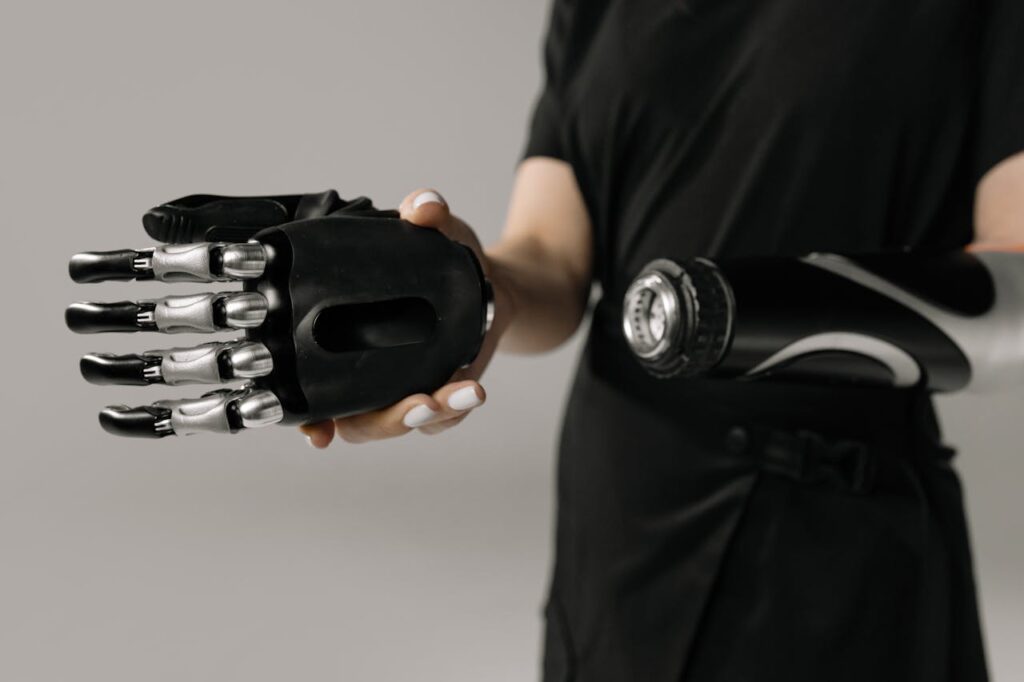
Expanding Access Through Cost-Effective Solutions
While military prosthetics often feature cutting-edge technologies, their high costs can be prohibitive for civilian users. Addressing this challenge requires a focus on scalable production methods and affordable designs that retain essential features.
Innovations such as 3D printing and modular manufacturing can significantly reduce production costs, making advanced prosthetics accessible to a broader audience. By collaborating with governments and non-profits to subsidize costs, businesses can ensure that even the most advanced devices are within reach for underserved populations.
At Robobionics, we are committed to breaking down cost barriers, delivering world-class prosthetics that combine innovation with accessibility.
A Legacy of Innovation and Empowerment
Military advancements in prosthetics have not only revolutionized assistive technology but also reshaped the lives of countless individuals. The lessons learned from battlefield tech—durability, adaptability, modularity, and emotional empowerment—are paving the way for a future where prosthetics are more than functional devices; they are tools of transformation.
Elevating User Confidence Through Innovation
Military prosthetics have shown how technology can transform lives by restoring lost capabilities and instilling a renewed sense of confidence.
Devices developed for soldiers are designed not only to endure extreme conditions but also to perform tasks that demand precision, strength, and adaptability. This dual emphasis on function and reliability creates a sense of trust between the user and the device.
For businesses, the takeaway is clear: prosthetics should be engineered with the user’s daily challenges in mind, combining advanced features with robust designs.
A prosthetic that seamlessly integrates into the user’s lifestyle—whether that involves playing sports, pursuing a career, or managing household tasks—can become a source of empowerment.
Highlighting these capabilities in product demonstrations, marketing campaigns, and user stories can reinforce the message that prosthetics are tools for reclaiming independence and confidence.
Supporting Holistic Empowerment
One of the most profound lessons from military prosthetics is the importance of addressing the whole person, not just the injury. Soldiers often face a complex journey of recovery that includes physical, emotional, and psychological dimensions.
Military rehabilitation programs recognize this and provide integrated support systems that address all aspects of recovery.
In civilian applications, businesses can adopt a similar approach by offering holistic solutions that go beyond the prosthetic itself. For example, partnering with occupational therapists and mental health professionals ensures that users receive comprehensive support.
Workshops that focus on skill-building, stress management, and peer connection can foster a sense of community and belonging.
Bridging Innovation and Accessibility
Military prosthetics are often at the forefront of technological advancements, incorporating features like brain-controlled interfaces, sensory feedback, and rugged modular designs.
However, these cutting-edge technologies can be cost-prohibitive, limiting their availability to the broader population. Businesses in the prosthetics industry have an opportunity to honor the legacy of military innovation by focusing on accessibility.
One actionable strategy is to streamline manufacturing processes through technologies like 3D printing, which allows for cost-effective production without sacrificing customization or quality.
Modular designs, inspired by military prosthetics, can further enhance affordability by enabling users to upgrade or replace specific components rather than purchasing an entirely new device.
Inspiring the Next Generation of Prosthetic Technology
The lessons learned from military prosthetics offer a foundation for future innovation. By studying how these devices perform under extreme conditions and how they adapt to diverse challenges, businesses can identify opportunities for continuous improvement.
Emerging technologies such as AI-driven customization, bioengineered materials, and IoT-enabled connectivity have the potential to redefine prosthetics yet again.
Businesses should consider investing in research and development that draws inspiration from military advancements while tailoring solutions for civilian users.
Collaborations with universities, tech companies, and military research institutions can accelerate this process, bringing groundbreaking features to market faster.
Highlighting these forward-thinking efforts in communications and branding reinforces a company’s position as an industry leader.
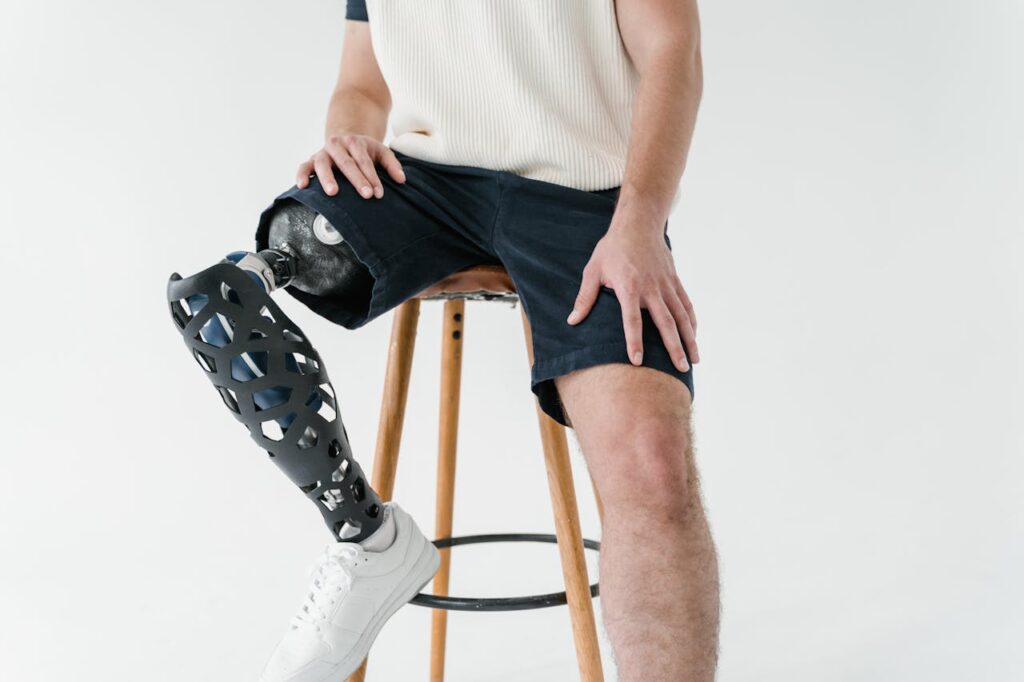
Building a Legacy That Transcends Borders
The impact of military innovations in prosthetics extends far beyond national or cultural boundaries. These technologies have the power to transform lives globally, offering hope and opportunity to individuals who face mobility challenges.
Businesses have a unique role to play in ensuring that this legacy reaches its full potential, not only by delivering innovative solutions but also by advocating for policies and partnerships that promote inclusivity and equity.
At Robobionics, we are inspired by the resilience and ingenuity of military prosthetic designs. By building on this legacy, we strive to create solutions that empower individuals to live boldly and without limits.
Our commitment to innovation, accessibility, and holistic support ensures that every device we produce contributes to a future where no challenge is insurmountable.
Conclusion
Military innovations in prosthetics have provided groundbreaking solutions that extend far beyond the battlefield. These advancements, driven by the urgent needs of soldiers, have redefined durability, adaptability, and functionality in prosthetic design.
From modular systems and neural interfaces to sustainable materials and personalized aesthetics, the lessons learned from military technology are shaping the future of prosthetics for all.
For businesses, these innovations present an unparalleled opportunity to create prosthetics that not only restore mobility but also empower users emotionally and mentally.
By embracing collaboration, sustainability, and user-centric design, companies can bridge the gap between military-grade advancements and everyday accessibility, ensuring these transformative technologies are available to everyone who needs them.



